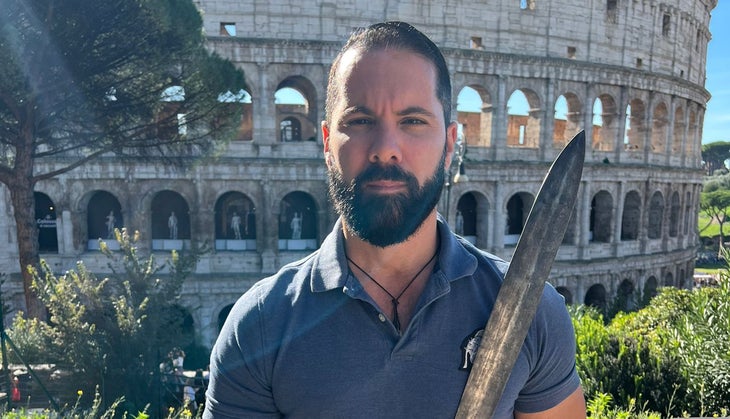For the past two summers, TikToks of Paul Mescal’s training regimen for Ridley Scott’s Gladiator II have gone viral. Mescal, an Irish actor known for his breakout role in Hulu’s adaptation of the Sally Rooney novel Normal People, looks ripped. In one of the videos, which has over 2 million views, Mescal does continuous upright rows with dumbbells for over 20 seconds. I can’t discern the weight he’s holding, but I can see from his strained face and measured breathing that it isn’t light.
@letterboxd 5 stars #fyp #foryou #letterboxd #filmtok #film #movie #gladiator #paulmescal ♬ gimme gimme gimme – ·:*¨༺ ♱✮♱ ༻¨*:·
I have to be honest, though, when the internet started salivating over Mescal’s physique, I wondered, is that—at all—what gladiators looked like? What do we actually know about gladiators’ diet, exercise, and appearance? Frankly, it all seems ripe for some real Hollywood inaccuracy.
To answer my questions, I talked to Alexander Mariotti, a.k.a “The Gladiator Historian.” Mariotti, who has been a historical consultant on numerous films and television series, including Gladiator II, also lives a bit like a gladiator, so he is a wealth of information on my Paul Mescal-focused queries and the gladiator diet, exercise, and philosophy in a much broader sense.

OUTSIDE: We’ve all seen the videos of Paul Mescal working out to play Lucius in Gladiator II. Does his physique align with what we know about real gladiators?
MARIOTTI: Well, [Mescal’s body] is built for a different reason. It’s a physique built for a short period of time and not to be an enduring athlete. So, the aesthetic is important for the movie, but it doesn’t actually have to perform. The Romans believed, above all, that the body should be functional. And certainly, I think for people like Mescal when you’re training, there is a level of functionality, too, because he’s got to perform all those scenes.
So the Romans weren’t into how fit they looked?
There’s a very interesting break in culture between the Romans and the Greeks (after the Romans conquered the Greeks), where the Greeks became obsessed with diets, and they wanted to look like statues (like this). If you look at modern gym culture, it’s very much the same. You’ve got some people who aesthetically look great, but they can’t do anything. They’re physically perfect, but they can’t run, can’t lift, can’t play. I see that in our culture as well, with what the Romans warned about: excessive obsession with the “look.”
Work Out Like a Gladiator
So, what do we actually know about how gladiators trained? Is there such a thing as a “gladiator workout?”
I can give you a very good idea, because I use it, and I’ve used it now for probably 15 years. It’s a system called the Tetrad. It’s a four-day split, and it was originally devised by Greek trainers for the Olympics. But it was such a good system that it made its way into the Roman army.
The way it works is that the first day is a preparatory day. The second day they called “an inescapable test of one’s limits.” The third day is rest, because they believe that rest and recovery are very important. And the fourth day is a skills day.
What might using the Tetrad gladiator training system look like for a modern person?
Day 1: On the preparatory day, I tend to do rowing. Nothing’s more ancient than being in a galley on a ship. I’ll do maybe 2,000 meters of rowing and then put in something else aerobic, like a short circuit, but nothing that’s going to exhaust me.
Day 2: The next day is when I do a full workout. The Romans had medicine balls, so you can use a kettlebell, medicine balls, circuits, weights, whatever. But the point is to test the limits of your body, to do more than you can do, to do as much as you can do.
Day 3: The third day you rest; that’s very important.
Day 4: The fourth day is skills. And skills, for me, is boxing training. So, I’ll do circuits on boxing, which are very similar to the movements they used in gladiator fighting.
Eat Like a Gladiator
And what about gladiators’ diets? Were they really the barley eaters that ancient texts describe?
Mike Tyson couldn’t survive off barley alone. The human body hasn’t evolved in the last 2,000 years. Our capabilities are what they are. If you took a heavyweight boxer and you started feeding him barley and ash, he wouldn’t be able to perform at the level he needed. So, yes, they were given sustenance.
They were given a stew in the same way that sumo wrestlers are given stews to fatten them up. You had to, in a very economic way, feed your fighters. It’s findings in places like Herculaneum that are breaking these myths and giving us the understanding that they had very varied and balanced diets—just like us—including meat, fish, and cheese.
Gladiators, they’re just like us. Gladiators were people. Gladiators were high-performance athletes. Just like with modern fitness, their diet and exercise would have been honed and iterated upon by those who had a vested interest in their performance over the course of centuries.
Knowing they prized functionality over appearance gives me a critical eye for my own viewing of pop culture. That said, even if movies aren’t perfectly historically rendered, their role is to entertain and inspire. They’re allowed to deviate.
This interview has been edited for brevity and clarity.
Prior to Outside, Ryleigh Nucilli was the Senior Manager of Ranker’s Weird History brand, where she spent lots of time investigating the historical accuracy of pop culture. Her work on gladiators’ diets can also be found in The New York Times bestseller Gastro Obscura: A Food Adventurer’s Guide.
